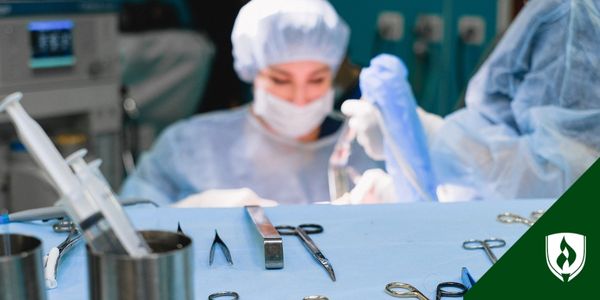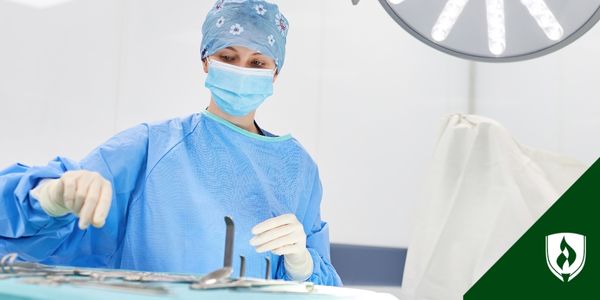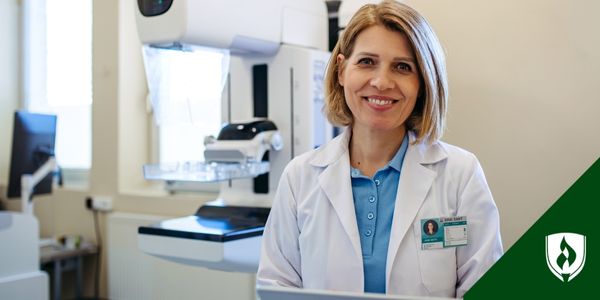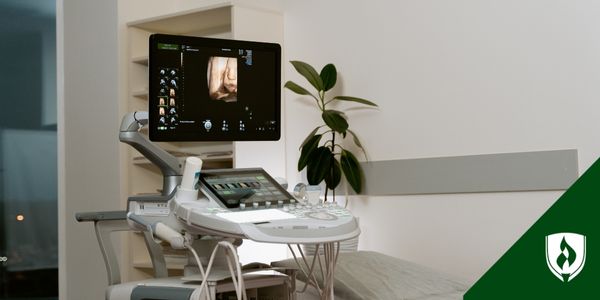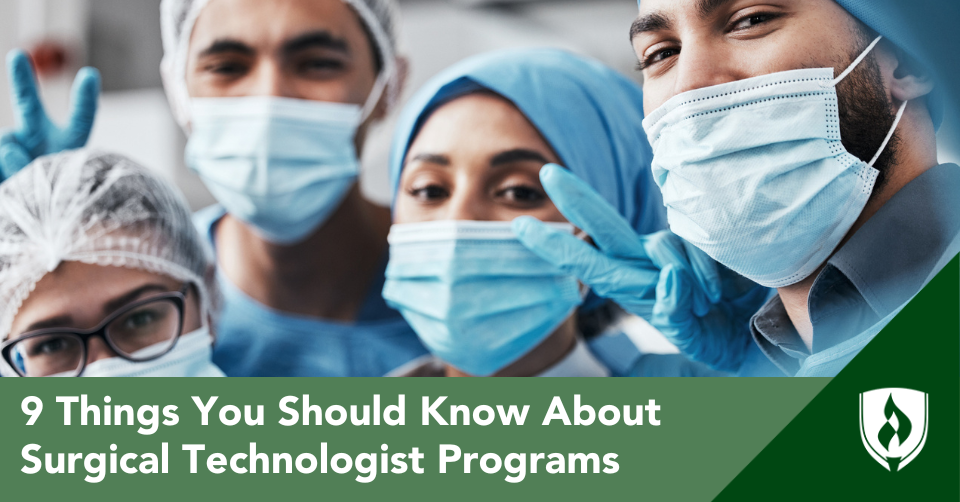
Surgical technologists (sometimes called surgical techs) preside over the surgical environment, protecting the sterile field, selecting surgical tools, draping surgical robots and more. These unsung healthcare heroes are crucial members of the surgical team.
Surgical technologists are different from surgical assistants—there are lots of different roles in the operating room! (If that interests you, check out Operating Room Jobs: Who's Who in the OR?)
Many people don’t realize that surgical technology is the optimal career for someone who wants to work with their hands in healthcare, but isn’t interested in lots of patient interaction.
“You say hello to the patient, then they go to sleep!” says Jill Teodoro, Professor in the Surgical Technology program at Rasmussen’s Romeoville/Joliet, Illinois campus.
If you want to help save lives, and you want to do it with your hands (literally holding their organs)—a surgical technology program is your step forward.
But first, what is a surgical technology program like? What should you expect? Is there anything you will regret not knowing before you enroll? Surgical technology isn’t for everyone, so read on to find out if an education in surgical technology is really what you want.
Here are 8 things you should know about surgical technology programs
1. They exist! As associate degree programs
Most people don’t know that surgical technologist is a career, let alone that a surgical technology program is an option.
If you graduate a surgical technology program, you’ll typically earn an associate’s degree. That level of degree program takes less time and investment than a traditional 4-year college degree. The surgical technology program at Rasmussen takes as few as 21 months to complete.1
If you want to work in the operating room, surgical technology is one of the quickest ways you can get there.
A surgical technologist program needs to prepare you for a national certification examination through the national board of surgical technology. You need to pass this exam to work as a surgical tech, so take a look at the pass rate of any program you’re interested in.
2. Most of us are here for the blood and guts
“I was hooked by the blood, guts and open bellies!” Teodoro says. She initially went to college majoring in biology, but realized her career options were basically medical school or research.
“But I didn’t want to work in a lab all day, and I didn’t want lots of patient contact.”
So she pivoted. “My mom worked with someone whose spouse was a surgical tech, and I was like what in the world is that?” After some research, Teodoro got excited and told her family about the role. They said, “Oh that sounds kind of gross.”
“I said—oh yeah! It’s totally for me!” Teodoro remembers with a laugh.
The very tactile and somewhat gory nature of the job appeals to many surgical technologists. That, and the ability to help people.
“The fact that we work with the surgical team to better patients’ lives, but don’t have to interact with patients directly is a huge draw. And we are doing actual surgical procedures, we stand diagonal to the surgeon.”
3. A surgical technology program can be hybrid, but not entirely online
Since surgical technology involves lots of physical skills, education for this career mostly goes down in-person, at a lab where students practice sterile technique, draping and learning procedures for tons of different operations. There are some things you just need to memorize and study (at Rasmussen, these two courses are online). But most of the education is active and physical.
“We are a skill-based residential program,” says Krista Vylasek, Professor for the Surgical Technology program at Rasmussen’s Anoka/Hennepin campus in Minnesota. She says the program does have an online component. Surgical technology students take their general education courses and two core surgical technology courses online.
The rest of the courses are in-person on campus.
4. These programs are kind of intense
“This is a rigorous program,” Vylasek says. “We work them hard, and we teach them a lot.”
The program prepares you for the field of surgical technology. In under two years, you need to learn the process and procedure for most operations, all the surgical tools and what to do with them, as well as how to create and maintain a sterile field, draping and more.
“The students who really thrive have that grit. They come in knowing they want to do this, and that they're going to do what it takes to make their career happen,” Vylasek says.
“The operating room (OR) can be a high-stress area, and you have to be able to adjust to your surroundings. People often think it’s easier than it is.”
There’s a lot of anatomy and physiology surgical technologists have to learn, as well as every type of procedure. Because of that, Teodoro says the surgical technology program is fast-paced. “In the first quarter, we go over 10 chapters in 10 weeks in addition to learning skills and labs. It takes a lot of dedication.”
But great professors make this work enjoyable.
“We like to have fun,” Vylasek says. “I’ll bring goofy stuff into the lab. Soon, I’m bringing pumpkins in so we can do pumpkin ‘seedectomys,’ practice incisions and pull-out seeds.”
5. You’ll learn about robotics
No, you haven’t accidentally stumbled into a technology program. Today’s operating room just looks a lot more sci-fi than it did a decade ago.
“The biggest industry change is the robots!” laughs Teodoro. “Many surgeries are now performed robotically.” She says a surgical assistant will run the little robot arms while the surgeon runs the robot from a console that looks like an arcade game.
Surgical technologists need to get the robot ready for each procedure.
“You have to learn how to drape the robot, load sutures for the robot, it’s part of the surgical team!” Teodoro says.
6. Each program handles clinical education differently
Like many allied healthcare programs, surgical technologist programs include clinicals. These are basically course credits assigned to work you’ll take on in a healthcare facility outside of school, working under the supervision of a preceptor as you practice all the techniques you learned.
When you are choosing a surgical technology program, look closely at their schedule to identify when clinicals happen—because this can make a huge difference in your success.
“I feel like our students are better prepared for clinical rotation because they spend a full year with us, on campus, in the lab, before they do clinicals on their own,” Teodoro says. She’s taught in other programs and says, “some programs mix you into clinicals too quickly, before you’ve learned enough to have some confidence.”
“Feedback from our clinical sites is that our students are better prepared and don’t need as much hand-holding.”
7. You might gravitate toward certain types of surgeries
During the program, surgical technologist students at Rasmussen will scrub 120 different cases among different surgical specialties, according to Teodoro. 30 of these cases will be in general surgery, then 90 cases will fall within different surgical specialties, including:
- Obstetric and gynecologic
- Oral Maxillofacial
- Genitourinary
- Plastics and reconstructive
- Ophthalmologic
- Neurologic
- Cardiothoracic
For the clinicals, Rasmussen’s program tries to place students in two different types of facilities so they get practice with different surgical specialties.
“I have students who really want a certain surgery,” Teodoro says. You might say “I’m here because I want to help deliver babies, I want to work in labor and delivery.”
Some surgical technologist students really want to work with kids, so Teodoro created a contract with a children’s hospital downtown.
“You might decide, hey, all I want to do is bones,” Teodoro says. By the time you work through all 120 different cases, you might have a preference for the types of operations you want.
That can inform your job search after you become a certified surgical technologist.
“For the most part, surgical technologists work in hospitals, surgery centers and mother baby care facilities.” She adds that there are positions in other places as well, though. Some clinics have surgical technologists for specific procedures they do often, like mole removal. Some surgical technologists work with oral surgeons in dentistry!
8. The curriculum adapts to the industry
To keep their status of accreditation, surgical technologist programs need to adopt curriculum changes put out by the commission on accreditation.
“Our accrediting body works closely with the Association for Surgical Technologists,” Teodoro says. “Every few years, they update the curriculum to keep up with technology and operative procedure.” For example, in the most recent updates, the core coursework has a lot more on robotics.
Rasmussen's program is accredited. The Surgical Technologist AAS Program at the Hennepin/Anoka, Minnesota, campus, the Central Pasco, Florida, campus, and the Rockford and Romeoville/Joliet, Illinois, campuses is accredited by the Commission on Accreditation of Allied Health Education Programs (CAAHEP.org) on the recommendation of the Accreditation Review Council on Education in Surgical Technology and Surgical Assisting (ARC/STSA®).
9. Instructors will have a huge impact on your experience
Surgical technology is a very hands-on career. When you are working through a program, you will take a very active role. This isn’t a sit-in-the-lecture-hall situation. A day as a surgical technologist student will feel more like an apprenticeship than anything else. So the teachers you learn from make a big difference.
“We tend to share our stories,” Teodoro grins.
Vylasek agrees, “We all have these years and years of experience, and it’s pretty diverse between each instructor.” She explains that some faculty members have a strong background in specialty areas, like cardio, and some of the adjunct instructors have experience working as traveling surgical techs and combat medics.
“Wide backgrounds and skill sets in the instruction is a huge advantage for students,” Vylasek says. Learning about each professor’s work can help you decide how you want to approach your own career, and it can open your eyes to different aspects of healthcare.
And of course, you want professors who are not only great surgical technologists—but great teachers as well. Are they passionate about teaching and training students?
“I love when the students first start, the fundamentals,” Teodoro says. She explains that students come in knowing absolutely nothing about surgical technology, and she gets to watch each realization dawn.
“It’s like, you’ve been washing your hands all your life, but this is sterile technique—I see them progress and really start to get it.”
How to enroll in a surgical technology program
A good program prepares you to become a certified surgical technologist (CST). If you care about quality patient care and the importance of healthcare, and if you could see yourself working with a surgical team, this might be your dream career.
Rasmussen's surgical technology program entrance requirements include scoring a 48.5% or higher on the TEAS test or achieving a composite score of 75% or higher on HESI A2® (Health Education Systems Inc Admissions Assessment) completed within 365 days of a signed enrollment agreement and transferred to Rasmussen at your expense.
A hands-on career with plenty of opportunity nationwide, and a stable position in the healthcare industry are some of the nuts-and-bolts attractions to this job. But surgical technologists know that whenever they get to work, they’re creating a force field of extra safety around patients who need surgery.
If you might be into that, hospitals and surgery centers need you. Get all the important details worked out at Rasmussen's Surgical Technology program page.
1Completion time is dependent on transfer credits accepted and the number of courses completed each term.
ARC/STSA® is a registered trademark of Accreditation Review Council on Education in Surgical Technology and Surgical Assisting non-profit corporation COLORADO 19751 East Mainstreet, Suite 339 Parker COLORADO 80138
HESI A2® is a registered trademark of ELSEVIER INC. CORPORATION NEW YORK 360 PARK AVENUE SOUTH NEW YORK NEW YORK 10010

